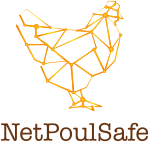Awareness central to keep bird flu away
After nearly six months without bird flu, bird flu (HPAI) was detected again at a poultry farm in July. Biosecurity measures do not offer a 100% guarantee that animals will not become infected, but they do reduce the risks. What should poultry farmers pay attention to? Being aware and consistent is essential.
In this article the NetPoulSafe activities in the Netherlands are described. Network Facilitator Annick Spaans says that “Poultry farmers know they should change shoes and work hygienically, but compliance can be improved. As a farmers’ association, we want to provide support so that biosecurity is higher on poultry farmers’ priority list.”
As one of the activities, ZLTO did a trajectory with seventeen poultry farmers from different subsectors from March 2022 to March 2023. Because of corona and bird flu, the meetings were online. In order to bundle knowledge and create support to actually make changes, ZLTO focuses strongly on the cooperation between poultry farmer, veterinarian and advisors from feed and breeding. A. Spaans: “We know that is effective.” Coaching and sessions about farm zoning, involving all these parties, were part of this trajectory. In addition, the article explains the Biocheck.Ugent scoring tool. Also insights from other interviewees about biosecurity can be read in the article.
Login to the www.boederij.nl website is required to read the article.
Sharing knowledge about biosecurity
The nation Network Facilitator of Netherlands, Annick Spaans, explains about the NetPoulSafe project. Among others, Annick tells about the one-year Dutch NetPoulSafe trajectory, which includes online group meetings, coaching and a farm zoning session
We hope that people will start thinking more consciously about biosecurity measures.
A. Spaans, ZLTO
One of the coaches who implemented supporting measures in Pilot Farms, Hilde Franse, also speaks about her experiences of the project.
” I think biosafety is an interesting topic. Because I had little experience with poultry, I was curious to see how other poultry farmers dealt with biosecurity. What I found interesting, for example, is how others approached the routing in the farm. In our case, it is not yet very practical. Our arable area is right next to the stables, so the logistical routes for the poultry are shared with the tractors that go into the fields. We are planning to build new stables and we are taking this into account. “
H. Franse
This article is available in the newspaper Nieuwe Oogst, 04/08/2023.
Breeding companies are proactive in implementing biosecurity measures
The primary goal of biosecurity procedures in poultry production systems is to reduce the introduction of infectious diseases into the farm. If an infection is introduced and spreads, the protocols attempt to limit disease spread inside and between farms. Therefore, good biosecurity should be applied at all times and not just during a disease outbreak.

Poultry breeding and rearing facilities need to fully understand the importance of maintaining high standards to ensure the safety and quality of the downstream poultry production chain. Understanding what is going on in terms of biosecurity in breeder farms may be the first step toward making the required modifications to make farms less vulnerable to disease invasion.This study is a quantitative assessment of common practices used by poultry breeding companies to improve the biosecurity of their flocks. Although, the application of conventional biosecurity measures on breeding farms was generally found to be high and agreeable, in some farms it was found inadequate.

